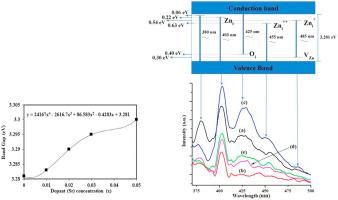当前位置:
X-MOL 学术
›
Solid State Sci.
›
论文详情
Our official English website, www.x-mol.net, welcomes your feedback! (Note: you will need to create a separate account there.)
Blue-shift in the optical band gap of sol-gel derived Zn(1-x)SrxO nanoparticles
Solid State Sciences ( IF 3.5 ) Pub Date : 2020-10-01 , DOI: 10.1016/j.solidstatesciences.2020.106379 Ashok Kumawat , Saikat Chattopadhyay , Kamakhya Prakash Misra , Nilanjan Halder , Sushil Kumar Jain , Banwari Lal Choudhary
Solid State Sciences ( IF 3.5 ) Pub Date : 2020-10-01 , DOI: 10.1016/j.solidstatesciences.2020.106379 Ashok Kumawat , Saikat Chattopadhyay , Kamakhya Prakash Misra , Nilanjan Halder , Sushil Kumar Jain , Banwari Lal Choudhary

|
Abstract Zn(1-x)SrxO nanoparticles (x = 0.00, 00.01, 0.02, 0.03, 0.05) are prepared by sol-gel co-precipitation. Strontium (Sr) doping causes small but highly significant band gap enhancement that amounts 0.58%. This band gap engineering, following a quartic variation with respect to dopant concentration (x), may find potential applications in the fabrication of various devices based on heterojunctions. The structural analysis of the nanoparticles is done using XRD. The randomly oriented polycrystalline nanoparticles (NPs) notice a decrease in lattice parameters for initial two doping levels, thereafter an increment. The crystallite sizes range between 10.54 and 27.76 nm, along various crystallographic planes. Due to Sr doping, dislocations are also caused whose density vary between 1.2 × 1015 and 9.0 × 1015 lines/m2. FTIR analysis confirms the presence of Zn–O bond prominently in tetrahedral mode. UV–Vis spectra reveal a dip at the wavelength corresponding to the band gap of NPs with different Sr concentration. Tauc's plot yields the band gap of undoped ZnO as 3.281 eV which gets augmented up to 3.30 eV by 5 at.% Sr doping. This band gap enhancement is an outcome of infiltration of Sr into the ZnO matrix, rather than substitution. PL emission spectra contain the peaks in UV and visible (violet-blue) range. The UV peak, arising from band-to-band exciton recombination, gets blue-shifted with Sr incorporation into ZnO. Violet-blue emissions, mainly originating from defect levels, see the changes only in their intensities. The surface morphology, through FESEM, presents elongated spherical, hexagonal and platelet kind of structures with interlinking granular chains. Interlinks densify with initial doping, whose role has been comprehended in governing the violet-blue emission. Sr doping of 3 at.% is found to have larger voids in the granular distribution. For highest doping interlinkages appear to resume. For compositional analysis EDX is performed, which confirms the presence of Sr in all doped ZnO NPs.
中文翻译:

溶胶-凝胶衍生的 Zn(1-x)SrxO 纳米粒子的光学带隙蓝移
摘要 Zn(1-x)SrxO 纳米粒子 (x = 0.00, 00.01, 0.02, 0.03, 0.05) 通过溶胶-凝胶共沉淀法制备。锶 (Sr) 掺杂导致小但非常显着的带隙增强,达到 0.58%。这种带隙工程,随着掺杂浓度 (x) 的四次变化,可能会在基于异质结的各种器件的制造中找到潜在的应用。纳米颗粒的结构分析是使用 XRD 进行的。随机取向的多晶纳米粒子 (NP) 注意到初始两个掺杂水平的晶格参数降低,然后增加。沿各种晶面的微晶尺寸范围在 10.54 和 27.76 nm 之间。由于 Sr 掺杂,也会引起位错,其密度在 1.2 × 1015 和 9.0 × 1015 线/平方米之间变化。FTIR 分析证实了 Zn-O 键在四面体模式中的显着存在。UV-Vis 光谱揭示了对应于具有不同 Sr 浓度的 NPs 带隙的波长处的下降。Tauc 的绘图得出未掺杂的 ZnO 的带隙为 3.281 eV,通过 5 at.% Sr 掺杂可增加至 3.30 eV。这种带隙增强是 Sr 渗入 ZnO 基体而不是取代的结果。PL 发射光谱包含紫外线和可见光(紫蓝色)范围内的峰值。由带间激子复合产生的 UV 峰随着 Sr 掺入 ZnO 发生蓝移。紫蓝色发射,主要来自缺陷水平,仅在其强度上发生变化。表面形貌,通过FESEM,呈现拉长的球形,具有相互连接的颗粒链的六边形和片状结构。互连通过初始掺杂致密,其作用已被理解为控制紫蓝色发射。发现 3 at.% 的 Sr 掺杂在颗粒分布中具有更大的空隙。对于最高的兴奋剂互连似乎恢复。为了进行成分分析,进行了 EDX,这证实了所有掺杂的 ZnO NP 中都存在 Sr。
更新日期:2020-10-01
中文翻译:

溶胶-凝胶衍生的 Zn(1-x)SrxO 纳米粒子的光学带隙蓝移
摘要 Zn(1-x)SrxO 纳米粒子 (x = 0.00, 00.01, 0.02, 0.03, 0.05) 通过溶胶-凝胶共沉淀法制备。锶 (Sr) 掺杂导致小但非常显着的带隙增强,达到 0.58%。这种带隙工程,随着掺杂浓度 (x) 的四次变化,可能会在基于异质结的各种器件的制造中找到潜在的应用。纳米颗粒的结构分析是使用 XRD 进行的。随机取向的多晶纳米粒子 (NP) 注意到初始两个掺杂水平的晶格参数降低,然后增加。沿各种晶面的微晶尺寸范围在 10.54 和 27.76 nm 之间。由于 Sr 掺杂,也会引起位错,其密度在 1.2 × 1015 和 9.0 × 1015 线/平方米之间变化。FTIR 分析证实了 Zn-O 键在四面体模式中的显着存在。UV-Vis 光谱揭示了对应于具有不同 Sr 浓度的 NPs 带隙的波长处的下降。Tauc 的绘图得出未掺杂的 ZnO 的带隙为 3.281 eV,通过 5 at.% Sr 掺杂可增加至 3.30 eV。这种带隙增强是 Sr 渗入 ZnO 基体而不是取代的结果。PL 发射光谱包含紫外线和可见光(紫蓝色)范围内的峰值。由带间激子复合产生的 UV 峰随着 Sr 掺入 ZnO 发生蓝移。紫蓝色发射,主要来自缺陷水平,仅在其强度上发生变化。表面形貌,通过FESEM,呈现拉长的球形,具有相互连接的颗粒链的六边形和片状结构。互连通过初始掺杂致密,其作用已被理解为控制紫蓝色发射。发现 3 at.% 的 Sr 掺杂在颗粒分布中具有更大的空隙。对于最高的兴奋剂互连似乎恢复。为了进行成分分析,进行了 EDX,这证实了所有掺杂的 ZnO NP 中都存在 Sr。


























 京公网安备 11010802027423号
京公网安备 11010802027423号